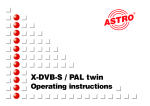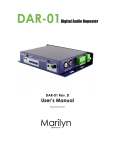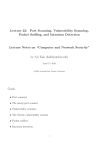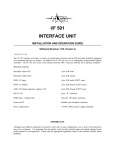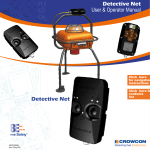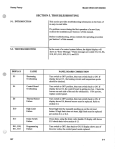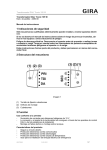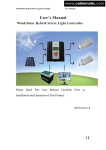Download Operating instructions: Hand programming tool Type: DALI
Transcript
Operating instructions: Hand programming tool Type: DALI HPT ADVANCED OSRAM GmbH Costumer Service Center Albert-Schweitzer-Str.64, 81735 Munich, Germany Tel. : +49 (0) 1803 677 - 200 Fax : +49 (0) 1803 677 - 202 www.osram.com www.osram.de Contents 1 Function of the hand programming tool (HPT) ................................................................................................. 3 1.1 Overview of displays and controls............................................................................................................. 3 1.2 Basic operation of the HPT ....................................................................................................................... 4 1.3 Setting up a connection to the central controller ....................................................................................... 5 2 Starting up the lighting control system.............................................................................................................. 6 2.1 Starting up the DALI side .......................................................................................................................... 6 2.2 Start up the radio side ............................................................................................................................... 8 3 Light control with the HPT ................................................................................................................................ 9 4 Additional functions and menu options........................................................................................................... 11 4.1 Control and motion detection .................................................................................................................. 11 4.2 Deleting radio components / changing radio functions............................................................................ 12 4.2.1 Deleting channels / changing single radio functions. ....................................................................... 12 4.2.2 Deleting radio transmitters completely ............................................................................................. 13 4.3 Changes in the DALI system................................................................................................................... 14 4.3.1 Change grouping ............................................................................................................................. 14 4.3.2 Adding a new DALI device to the system......................................................................................... 16 4.3.3 Changing the ballast address and group assignment of a DALI device ........................................... 17 5 Special functions ............................................................................................................................................ 18 5.1 Controlling several rooms with one central controller.............................................................................. 18 5.2 Protect lighting scenes ............................................................................................................................ 19 5.3 System Reset.......................................................................................................................................... 19 6 System settings.............................................................................................................................................. 20 6.1.1 Manual dimming speed (FadeRate)................................................................................................. 20 6.1.2 Fade time between lighting scenes and light values (FadeTime).................................................... 21 6.1.3 Behavior after return of mains voltage (PowerOn-Level) ................................................................. 21 6.1.4 Behavior on loss of DALI control voltage (System Failure-Level) .................................................... 22 6.2 Configuration of the HPT......................................................................................................................... 23 6.2.1 Language setting ............................................................................................................................. 23 6.2.2 Setting of display contrast................................................................................................................ 23 7 Failure of system components ....................................................................................................................... 24 7.1 Replacement of a defect DALI device ..................................................................................................... 24 7.2 Replacement of defect central controller................................................................................................. 25 8 Possible error messages................................................................................................................................ 26 8.1 Error messages in setting up a link between HPT and central controller ................................................ 26 8.2 Error messages at radio startup .............................................................................................................. 26 8.3 Error messages in radio-addressing ....................................................................................................... 27 8.4 Error messages for lighting regulation..................................................................................................... 28 8.5 Error messages in reading DALI devices information ............................................................................ 28 9 Notes.............................................................................................................................................................. 29 10 Overview of the menu structure.................................................................................................................. 30 11 Notes on radio operation ............................................................................................................................ 31 12 Technical data ............................................................................................................................................ 32 page 2 Operating instructions: Hand programming tool DALI HPT ADVANCED 1 Function of the hand programming tool (HPT) The battery-operated HPT is necessary for start up, configuration, testing a and modification of a DALI ADVANCED lighting control system. The HPT is used for configuration of the electronic DALI control gears (=DALI devices) and allows the integration of radio components such as wall transmitters and sensors. For additional information please take a look at the operating manuals for the central controller type DALI RC ADVANCED CI respectively at the manuals of the corresponding radio components. 1.1 Overview of displays and controls LC-Display Cursorbuttons HPG On/Off, activate display lighting Switch on /off lighting Input confirmation Dimming up/down Cancel entry and back to last menu Number buttons 0...9 Battery charge status Radio link indication 0-0 MAIN MENU Lighting control .. Service .. Setting. > Startup .. Cursor position Operating instructions: Hand programming tool DALI HPT ADVANCED Help line page 3 1.2 Basic operation of the HPT The main menu gives you access to all the other menu options. The basic operating principle is the same in all menus: Main control panel: ON + OFF - 1. All the connected DALI devices can be operated directly from the main menu even without prior addressing or programming (broadcast mode). 2. Operation of the selected device, group or lighting scene. Cursor control and Direction buttons up and down. 1. Moving cursors in the menus 2. Direct selection of device numbers, short- or group addresses and lighting scenes in the value fields Direction button left: Delete last entry Direction button right: Cross-reference to the specified menu OK – button OK Confirm selection or entry ESC – button ESC 1. Abort the selected function (press short) 2. Return to previous menu (press long) Numeric keypad 0 ... 9 Enter numerical data in the value fields Dimming buttons + Fade to maximum brightness, if already switched on. - Fade to minimum brightness, if already switched on. On / Off button / display lighting Switch on/off the HPT (hold down button for about 2 seconds). With the HPT switched on, the display lighting can be switched on. If the HPT is not used for about 10 seconds, the display lighting is automatically switched off to preserve the battery. page 4 Operating instructions: Hand programming tool DALI HPT ADVANCED 1.3 Setting up a connection to the central controller Before a DALI system can be started up or operated with the aid of the HPT, the central controller and the HPT must be connected to one another by a radio link. When it is switched on, the HPT sends a special connection setup signal to all the central controllers within its range. All central controllers within connection distance respond with their identification number. A list of central controllers and their identification numbers will be displayed after some seconds. Then the desired central controller can be selected and controlled or configured. Steps in connection setup Switch on the HPT. INFO Version xxxx Language English >: DEUTSCH ESC SCAN CONNECTING controller .. found: For about 3 seconds a initial screen with the software version and the selected language will be displayed. As long as the initial screen is displayed, the menu language can be changed with the button directly between German and English. X ESC CONNECTING > Controller (12345) Controller (56789) OK: CONNECT >: BLINK SCAN CONNECTION to controller The HPT searches for central controllers within connection distance. During this process the message SCAN will be visible in the upright corner of the display. The number of central controllers that are already found is displayed. If its sure that only one central controller exits the further search process can be terminated by ESC. Subsequently the display shows a list of central controllers found. With the buttons a central can be selected. To check whether the correct central is selected, blinking of all fixtures connected to the selected central can be initiated with the button. If the desired central is found, confirm selection with OK. After the connection setup was successfully, a verification message with the software version of the central controller will be displayed for some seconds. SUCCESSFUL Version x.x 0-0 MAIN MENU > lightcontrol .. service .. setting/Einstellung start-up .. Then the main menu is called up. The antenna symbol for radio reception is displayed in the header line. If the radio link to the central controller threatens to break down the antenna symbol will flash. If the link is lost the symbol will disappear, the message "no RF connection to controller" will appear and the HPT will switch off. For possible error messages during connection setup see Section 8 Operating instructions: Hand programming tool DALI HPT ADVANCED page 5 2 Starting up the lighting control system As already mentioned, the system consists of a DALI side and a radio side. Before you put the system into operation you should take a little time to think about the functions that the system and the controls are going to perform. For large rooms we recommend you to make a diagram of the group assignments and enter the individual addresses of the devices. Considerations on the DALI side - How should the groups be assigned? - Which lighting scenes are to be set up in the room? - Which groups should be controlled by sensors? Considerations on the radio side - How many controls should be provided? - What functions should be assigned to the individual controls? - Where should the controls and sensors be positioned? - Is the radio link of all components secure? (Further information you’ll find in the manuals of the corresponding products) 2.1 Starting up the DALI side If the radio connection to the central controller is established, it is best to check whether all the connected DALI devices can be switched with the ON/OFF buttons and can be faded with the + / – buttons of the HPT. By testing the installation this way, possible faults of the wiring can be determined. When a DALI system is put into operation for the first time, all the connected DALI devices have to be initialised and assigned to groups. Initiate a DALI start up 0-0 MAIN MENU lightcontrol .. service .. setting/Einstellung > start-up.. 4-0 STARTUP > DALI Radio Select Startup with the buttons resp. and confirm selection with the OK button. Select DALI with the buttons resp. and confirm selection with the OK button. !Attention! When DALI is started up, all settings already made are deleted. This also applies to any devices already programmed. If you only want to do some changes in an existing installation it is better to proceed as described in chapter 4.3. If possible, the startup process should always be carried out to the very end. You can abort startup by holding down ESC at any time. An aborted DALI start up can be resumed by the menu point New device described in chapter 4.3.3. The DALI side of the lighting control system is independent of the radio side, so radio components that have already been "learned" are not deleted. page 6 Operating instructions: Hand programming tool DALI HPT ADVANCED 4-1 DALI START-UP initiate start-up? ! CAUTION ! System will be cleared 1: YES ESC 4-1 DALI START-UP search device… All the connected DALI devices are faded to the minimum lighting level. The system is searching for the first DALI device 4-1 DALI START-UP device found! program? OK Button 1 initiates the start up process. When the device is found the lamp connected to it flashes. Press OK to start the programming of this device. Should the fixtures be programmed in a special order (e.g. corresponding to the mounting place), the actual blinking device can be skipped with the ESC –button and programmed later on. ESC: SKIP 4-1 Should the programming be proceeded, a value field appears for entering the group address the fixture should belong to. Enter number of group (1 to 16) and confirm entry with OK. 4-1 The group number entered XX and an automatically generated ballast address YY are displayed. Desired group number and ballast address can by selected and edited with the cursor control. Programming is started with the OK button (it is urgently recommended to note the group resp. ballast address of every device for documentation of the installation.) 4-1 If programming is successful the device is switched to maximum level. Subsequently a search for the next device is carried out. After the last device has been programmed, the lighting will flash briefly and then switch to the minimum dimmer setting. 4-1 At the end of the startup routine a message appears giving the number XX of programmed devices. DALI START-UP group : DALI START-UP group ballast address : XX : YY > program device DALI START-UP device is programmed… DALI START-UP initiate completed! XX devices KEY Operating instructions: Hand programming tool DALI HPT ADVANCED page 7 2.2 Start up the radio side During the start up of the radio side all buttons or rocker switches of the control elements are individually learned and assigned a function. Also the sensors a learned to the system and assigned to a group. Initiate the radio start up 4-0 START-UP DALI .. > Radio .. 4-2 RADIO START-UP wait for channel operation... ESC Use the cursor to select the Radio option and confirm with the OK button. The central controller now waits for a radio telegram from a radio transmitter. This is sent by pressing the button that should be learned for a longer time or by inserting the batteries in a sensor. (For further details please have a look at the instruction manuals of the corresponding transmitters) 4-2 RADIO START-UP wall transmitter found channel 1 OK: LEARN ESC After successful reception of radio telegrams the transmitter type (here: Wall transmitter) and the functional type (here: channel 1) is displayed. Press OK to learn this transmitter or reject it and wait for next transmitter with a short press on ESC. (Radio start up can be aborted at any time pressing ESC for a longer time) 4-2 RADIO START-UP > controls group controls broadcast controls scene Dependent of the transmitter type or of the radio telegram type a menu choice is displayed. Here a selection is made whether group-, broadcast- or scene-control is linked with the corresponding radio telegram. The according menu point is selected with the cursors and confirmed with OK. At controls group and controls scene the desired group or scene number has to be entered and confirmed with OK on the next screen 4-2 RADIO START-UP channel learned connection setup device no. XX KEY Finally, a confirmation window appears. XX indicates the system-internal assignment number of the radio transmitter. (it is urgently recommended to note the number of each radio device that it can be unlearnt in case it is damaged or lost. ) For possible error messages during connection setup see Section 8 page 8 Operating instructions: Hand programming tool DALI HPT ADVANCED 3 Light control with the HPT The lighting can be controlled centrally (all devices) or groupwise with the HPT, as it is possible with other control elements (e.g. a remote control). In addition the light level of every luminaire can be adjusted individually. A lighting situation achieved in this way can be stored and recalled as so called light scenes. 0-0 Select menu point lightcontrol in the MAIN MENU with the buttons and confirm selection with OK. 1-0 For controlling a group select group with the buttons and press OK. MAIN MENU > lightcontrol .. service .. setting/Einstellung start-up.. LIGHT CONTROL > group scene all devices individual 1-1 LIGHT CONTROL > group The desired group is seleced by entering the group number and confirmation with OK. >: SCENE 1-1 LIGHT CONTROL group > brightness: >: SCENE Subsquently the cursor jumps to the point brightness. Now the brightness level (0–100%) for this group can be entered. After confirmation with OK the group changes to the corresponding brightness. With the buttons menu line group can be accessed again and next group can be adjusted as described. With the button the scene menu can be accessed directly 1-2 Should the actual lighting situation be stored as scene, the desired scene number (1-15) is entered here and confirmed with OK. LIGHT CONTROL scene : >:GROUP 1-2 Select the entry store scene with the cursor buttons and confirm storage with OK. LIGHT CONTROL scene : call up scene > store scene With the button it is possible to go back to Group control menu directly. >:GROUP 1-2 LIGHT CONTROL scene : > call up scene store scene >:GROUP By the menu point call up scene previously stored scenes can be recalled. Note : The fading time between scenes can be adjusted as described in section 6.1. Operating instructions: Hand programming tool DALI HPT ADVANCED page 9 1-0 With menu point all devices in the lighting control menu, the whole installation can be controlled . Please select the corresponding line with the cursors and confirm selection with OK. 1-3 The cursor jumps to the brightness entry automatically Now the brightness value (0 – 100 %) can be entered and confirmed with OK. The whole lighting will change to the entered level. LIGHT CONTROL LICHTSTEUERUNG Gruppe group Szene scene > all Zentral devices Individual individual LIGHT CONTROL all devices > brightness: 1-0 LIGHT CONTROL group scene central > individual.. With the menu point individual in the LIGHT CONTROL menu individual fixtures can be controlled. For this select the corresponding entry with the cursor buttons and press OK. 1-4 LIGHT CONTROL > ballast address For selection of the desired luminaire the ballast address is entered and confirmed with OK. brightness: 1-4 LIGHT CONTROL ballast address 1 > brightness Following the cursor changes to the menu point brightness automatically. Now the brightness level (0 – 100 %) can be entered and confirmed with OK. The luminaire will change to the entered brightness. Beside the described central, groupwise and individual percental demand, brightness can -in each case- also be directly adjusted by the + / - fading buttons or On/Off buttons of the HPT. page 10 Operating instructions: Hand programming tool DALI HPT ADVANCED 4 Additional functions and menu options 4.1 Control and motion detection If a combined light and motion sensor or a light sensor is linked for to a group (see chapter 2.2), the control of brightness can be enabled or disabled as well as a set value for the corresponding group can be programmed with the control menu 0-0 LIGHT CONTROL scene .. all devices individual .. > control .. Call up the control submenu from the main menu and press OK to confirm. 1-5 Enter the number of the group (1 to 16), that should be regulated and confirm with OK. CONTROL > group 1-5 CONTROL group: XX > change set value control ON [OFF] The actual brightness level can be stored as set value for the corresponding group by selection of the depicted menu entry and confirmation with OK. 1-5 CONTROL The next transmitted brightness value measured by the sensor will be stored as new set value. Note: This procedure can take up to 90 seconds. wait for light value .. ESC 1-5 CONTROL The successful acquisition of a new set value is displayed. You can press any button to return to the CONTROL menu. set value changed! KEY 1-5 CONTROL group: XX change set value > control ON The actual setting (ON/OFF)of the regulation is displayed. To change the current setting, select menu point control and enable the regulation of the corresponding group with the buttons 1, or ON or disable it with 0, or OFF Return to LIGHT CONTROL menu by pressing ESC. For further information concerning light regulation please take a look at the instruction manuals of the combined light and movement sensor type DALI LS/PD ADVANCED or the light sensor type DALI LS ADVANCED. Operating instructions: Hand programming tool DALI HPT ADVANCED page 11 4.2 Deleting radio components / changing radio functions If functions of channels are to be changed, these channels must first be deleted with the Service menu and then "reprogrammed" with the new functions as described in chapter 2. 2. 4.2.1 Deleting channels / changing single radio functions. 0-0 Call up the service submenu from the main menu and press OK to confirm. MAIN MENU lightcontrol .. > service .. setting/Einstellung start-up.. 2-0 Select submenu RF addressing and press OK to confirm. SERVICE DALI system DALI grouping .. > RF addressing .. 2-3-0 RF ADDRESSING > unlearn channel delete device 2-3-1 RF ADDRESSING wait for channel operation To delete a function of a radio transmitter, select menu option unlearn channel and press OK to confirm. The central controller now waits for a radio telegram from a transmitter that indicates the function to be unprogrammed. Now press the corresponding button of the handheld or wall transmitter or remove the batteries of a sensor and replug it after approx. 10s.. ESC 2-3-1 RF ADDRESSING wall transmitter found The telegram reception is displayed with the transmitter type and channel number as in the example depicted here. Confirm with OK to unlearn and the channel and the assigned function or otherwise cancel process with ESC. channel 1 OK: UNLEARN ESC 2-3-1 RF ADDRESSING channel unlearned connection deleted device no XX The completion of the unlearn is indicated by the following screen. Press any button to continue. KEY page 12 Operating instructions: Hand programming tool DALI HPT ADVANCED 4.2.2 Deleting radio transmitters completely With the device number of a transmitter all channels and functions can be deleted. If the device number is unknown it is recommend to unlearn one channel first, as described in the previous chapter, where the device number is displayed automatically. 2-3-0 To delete a radio transmitter and all its channels from the central controller, select menu option Delete Device and press OK to confirm . 2-3-2 Next, enter the device number and press OK to confirm. Press any button to continue Confirm security inquiry with OK or cancel process with ESC. RF ADDRESSING unlearn channel > delete device RF ADDRESSING device delete all allocations? 2-3-2 RF ADDRESSING device XX If the process is successfully finished, the depicted message is displayed . deleted! KEY For possible error messages during connection setup see Section 8 Operating instructions: Hand programming tool DALI HPT ADVANCED page 13 4.3 Changes in the DALI system 4.3.1 Change grouping In a DALI system that has already been put into operation, further devices can be added to or removed from the other groups via the Service .. menu.. 0-0 Select submenu service... in the MAIN MENU with the buttons and confirm selection with OK. MAIN MENU lighting control .. > service .. setting/Einstellung start-up.. 2-0 SERVICE DALI system .. > DALI grouping .. RF addressing .. Select DALI grouping and press OK. Remove / add single group members 2-2-0 Select menu point edit group and confirm with OK. 2-2-1 Enter the relevant group (1-16) and confirm with OK. The selected group is switched to maximum lighting level; all other groups dim down to the minimum lighting level. DALI GROUPING > edit group delete group DALI GROUPING group : 2-2-1 If a further device is to be added to the group, select the add device menu option . If a device should be deleted from the group select entry delete device. Confirm selection with OK. DALI GROUPING group : XX > add device delete device 2-2-1 DALI GROUPING group : XX > ballast address : OK: ADD (DELETE) page 14 The first assigned ballast address is automatically displayed and can be accepted by pressing OK. After a short delay the device with the displayed ballast address will flash. If a different device is to be accessed, use the buttons to call up the next assigned ballast address. With OK the device is added to or deleted from the group. Operating instructions: Hand programming tool DALI HPT ADVANCED Deleting a whole group 2-2-0 If a complete group is to be deleted, select the option delete group and confirm with OK. 2-2-2 Enter the number of the group that should be deleted and press OK. The selected group fades to maximum all other devices fade to minimum. DALI GROUPING edit group > delete group DALI GROUPING group : 2-2-2 DALI GROUPING group : XX Confirm security inquiry with OK or cancel process with ESC. delete all allocations? 2-2-2 DALI GROUPING group : XX The depicted message is displayed after the group was deleted. Press any button to continue. deleted! KEY Operating instructions: Hand programming tool DALI HPT ADVANCED page 15 4.3.2 Adding a new DALI device to the system If a new device has been connected to the controller it can searched, programmed with a ballast address and assigned to a group separately. 0-0 DALI SYSTEM > individual device .. controller .. scene.. Select menu point DALI System at the Service menu and subsequently the submenu individual device and confirm selection with OK. 2-1-1-0 INDIVIDUAL > new device change device exchange device The new device will be searched… 2-1-1-1 INDIVIDUAL device found! program? OK Next Select submenu new device and press OK to confirm. If the new device is found the lamp(s) connected to it flashes. The programming of this new device can be started with OK. Note: if more than one new device was added and should the new devices be programmed in a special order the actual flashing one can be skipped and programmed later on. ESC:SKIP 2-1-1-1 INDIVIDUAL group : Enter the number of the group (1..16) where this new device should be assigned to and confirm entry with OK. 2-1-1-1 INDIVIDUAL group : XX ballast address : YY > program device 2-1-1-1 INDIVIDUAL device is programmed ... The group address XX and the automatically generated ballast address YY are displayed. Programming can be started by pressing OK. If the automatically proposed ballast address is to be changed, select ballast address and press OK. Enter a different ballast address or select it with the buttons and press OK to confirm. The new device is programmed. After successful programming the device fades to maximum. If no new device is found please check if it is correctly connected to the controller and the line voltage and if it reacts to the central On/Off/Dimming functions of the HPT. Is the connection correct, but the device is still not found, it was obviously programmed before. In this case please follow the instructions on next page. page 16 Operating instructions: Hand programming tool DALI HPT ADVANCED 4.3.3 Changing the ballast address and group assignment of a DALI device The existing ballast addresses can be changed without influence to other settings (e.g. group assignment). Ballast addresses can be allocated several times, e.g. by connecting of previously installed devices. Nevertheless it is important for simplification of service that all ballast addresses are used only once and are therefore unique in the system. A ballast address that was a assign to different devices can be changed as follows. 2-1-1-0 Coming from the MAIN MENU select submenu service .. / DALI System .. / individual device and confirm with the OK button. INDIVIDUAL new device > change device exchange device Select menu point change device and press OK. 2-1-1-2 INDIVIDUAL ballast address : If known, enter ballast address of the corresponding device and confirm entry with OK . Otherwise select devices with the buttons one after another until the lamp(s) connected to the desired device flashes, confirm final selection with OK. 2-1-1-2 INDIVIDUAL ballast address : XX Select menu point allocate new address and press OK. change > allocate new address 2-1-1-1 INDIVIDUAL device found! program? OK ESC: SKIP The system searches for the devices with ballast address XX. The lamps of the first device with this address flash. The address of this device can now be changed by pressing OK or skipped by ESC. 2-1-1-1 INDIVIDUAL group: Enter desired group number (1 to 16) and confirm with OK. 2-1-1-1 INDIVIDUAL group : XX ballast address : YY > program device Check displayed group number and ballast address, if necessary select entry and change it with the arrow buttons. Start programming with the OK button. After the programming of this device is finished, the next device with the same ballast address is searched automatically. The change process is terminated when the last device with this ballast address was edited. Operating instructions: Hand programming tool DALI HPT ADVANCED page 17 5 Special functions 5.1 Controlling several rooms with one central controller A lighting scene normally effects all the DALI devices and therefore all the groups of the system. However there is the possibility of having a lighting scene, which affects only one particular group (e.g. the fixtures of a particular room). Example: Room no. 1 contains group 1, room no. 2 contains group 2. Lighting scenes 1 and 2 are to apply to Room 1; scenes 3 and 4 are to apply to Room 2. Scenes 1 and 2 are therefore assigned to Group 1 (= Room 1) and scenes 3 and 4 to Group 2 (= Room 2). This ensures that when the lighting scenes are stored the lighting situation in the next room is not stored at the same time and is not affected when the lighting scene is called up. Each lighting scene can be assigned only to one group. If a room contains more than one group, a superordinate group has to be created that contains all the devices from the other groups in the room. The lighting scenes can then be assigned to these superordinate -groups. 2-1-0 DALI SYSTEM individual device .. controller .. > scene .. Coming from the Main Menu select submenu service .. / DALI system .. / scene .. / combine scene and confirm selection with OK. In this menu each scenes can be assigned/linked to one particular group. 2-1-3-1 Enter scene number that should be assigned to a particular group and confirm entry with OK. 2-1-3-1 Enter desired number of desired group that should be linked with the selected scene and press OK. Next start programming process by pressing OK again. COMBINE SCENE scene COMBINE SCENE scene XX > controls group program device Remove Scene- / Group link: After Entry of „000“ at value field „Controls Group“ it appears „ – – – “. Set cursor to line Program and press OK to remove existing link. page 18 Operating instructions: Hand programming tool DALI HPT ADVANCED 5.2 Protect lighting scenes Normally lighting scenes can be changed by the HPT, by a handheld- and a wall transmitter. If it is desired light scenes can be protected against all changes derived from operation of wall-and handheld transmitters. 2-1-3-2 SCENE PROTECT All scenes protected against > changes ON [OFF] Coming from the Main Menu call up submenu service .. / DALI system .. / scene .. / Scene protect. The actual setting will be displayed. Select entry with OK, enable (ON) /disable (OFF) scene protect with the buttons and or 1 and 0 . Changing scenes with the HPT is always possible. 5.3 System Reset If you want to delete a DALI SYSTEM completely you can do this in the Reset System menu option. All the data of the connected system will be irretrievably deleted. This applies both to DALI devices and to linked radio components. 0-0 MAIN MENU lightcontrol .. > service .. setting/Einstellung start-up .. .. Coming from the Main Menu select submenu service.. / DALI system .. / controller .. and confirm selection with OK. 2-1-2-0 Select menu point reset system and press OK. 2-1-2-2 Confirm security prompt with button 1. CONTROLLER read out system > reset system CONTROLLER reset System ! CAUTION ! System will be cleared 1: YES ESC 2-1-2-2 CONTROLLER The system is deleted... reset in progress .. 2-1-2-2 CONTROLLER system reset completed KEY After the system reset was completed the depicted message is displayed. Press any button to continue. To reprogram the central controller, the HPT must now be switched off and the connection to the central controller reestablished. Operating instructions: Hand programming tool DALI HPT ADVANCED page 19 6 System settings The DALI ADVANCED system provides a possibility of configuration of important system parameters by the user, which allow an individual adaptation of the system behavior to the requirements of the user. 0-0 Coming from the Main Menu select menu setting and press OK. MAIN MENU lightcontrol .. service .. > setting/Einstellung start-up .. 3-0 Select submenu DALI – parameter and press OK. SETTING/EINSTELLUNG HPT / HPG .. > DALI parameter .. 6.1.1 Manual dimming speed (FadeRate) 3-2-0 DALI PARAMETER > FadeRate FadeTime PowerON-Level SystemFailure-Level The dimming speed for manual operation dimming is given by the ‚FadeRate’ value. Select menu point ‚FadeRate’ and press OK. 3-2-1 DALI PARAMETER FadeRate value > program device Enter ‚FadeRate’ value between 1 (fastest) and 15 (slowest) and confirm entry with OK. XX Apply setting by programming with the OK button. FADE RATE setting (dimming steps/sec) 0 1 2 3 4 5 6 7 8 9 10 11 12 13 14 15 not applicable 357.8 253.0 178.9 126.5 89.5 63.3 44.7 31.6 22.4 15.8 11.2 7.9 5.6 3.9 2.8 Overview : Settings for manual dinmming speed page 20 Operating instructions: Hand programming tool DALI HPT ADVANCED 6.1.2 Fade time between lighting scenes and light values (FadeTime) 3-2-0 DALI PARAMETER FadeRate > FadeTime PowerON Level SystemFailure-Level Select menu point ‚FadeTime’ and press OK. 3-2-2 DALI PARAMETER FadeTime value > program device The fading time is given by the ‚FadeTime’ value. XX FADE TIME setting 0 1 2 3 4 5 6 7 8 9 10 11 12 13 14 15 Enter ‚FadeTime’ value between 0 (fastest) and 15 (slowest) and confirm entry with OK. Apply setting by programming with the OK button. Fade time in sec <0,7 0.7 1.0 1.4 2.0 2.8 4.0 5.7 8.0 11.3 16.0 22.6 32.0 45.3 64.0 90.5 Overview : Fade time settings 6.1.3 Behavior after return of mains voltage (PowerOn-Level) The brightness after a power failure is given by the ‚PowerOn-Level’ value. 3-2-0 Select menu point ‚PowerOn-Level’ and press OK. DALI PARAMETER FadeRate FadeTime > PowerOn Level SystemFailure-Level ESC 3-2-3 DALI PARAMETER PowerOn-Level Value > program device XXX Enter ‚PowerOn-Level’ value between 1 (minimal brightness) and 254 (maximal brightness) or 255 (last state before power failure is reestablished) and confirm entry with OK. Apply setting by programming with the OK button. 255: LAST VALUE Brightness 1% 5% 10% 20% 145 170 196 Overview : Selected brightness settings after power failure PowerOn-Level value 85 50% 229 Operating instructions: Hand programming tool DALI HPT ADVANCED 80% 246 100% 254 Last state 255 page 21 6.1.4 Behavior on loss of DALI control voltage (System Failure-Level) The brightness after a loss of the DALI control voltage (e.g. when the control wires are cut) is given by the ‚System Failure-Level’ value. 3-2-0 DALI PARAMETER FadeRate FadeTime PowerON Level > SystemFailure-Level Select menu point‚ System Failure-Level’ and press OK. ESC 3-2-4 DALI PARAMETER SystemFailure-Level value > program device Enter ‚System Failure -Level’ value between 0 (lighting switches off) and 254 (maximal brightness) or 255 (Last state before loss of control voltage is retained) and confirm entry with OK. XXX Apply setting by programming with the OK button. 255: LAST VALUE Brightness System Failure-Level value 0% (Off) 1% 5% 10% 20% 50% 80% 100% Last state 0 85 145 170 196 229 246 254 255 Overview : Selected brightness settings after power failure page 22 Operating instructions: Hand programming tool DALI HPT ADVANCED 6.2 Configuration of the HPT To improve the ergonomic handling of the hand programming tool some settings of the HPT can be adjusted individually. 6.2.1 Language setting 3-0 SETTING/Einstellung > HPT / HPG .. DALI parameter Coming from the Main Menu select menu setting/Einstellung and press OK. Then select submenu HPT / HPG and press OK. 3-1-0 HPT Language/Sprache > contrast Select submenu Language/Sprache and press OK. 3-1-1 Use the buttons to change the menu language of HPT and press OK. HPT > Deutsch English 6.2.2 Setting of display contrast 3-1-0 HPT Language/Sprache > contrast Coming from the Main Menu select menu Einstellungen / Setting and press OK. Select submenu Contrast and press OK. 3-1-2 HPT Change display contrast with the buttons. < - contrast + > KEY Operating instructions: Hand programming tool DALI HPT ADVANCED page 23 7 Failure of system components The DALI ADVANCED system offers extensive service functions to simplify the replacement of defect components. 7.1 Replacement of a defect DALI device If devices have to be replaced in a DALI system, all the data of the replaced devices can be transferred. If there is more than one device to be replaced the ballast addresses and associated mounting locations must be known. Start the replacement process with the lowest ballast address. Disconnect system from mains voltage, demount device and subsequently reconnect mains again. 0-0 MAIN MENU lightcontrol .. > service .. setting/Einstellung start-up .. .. Coming from the Main Menu select submenu service .. / DALI system .. / individual device .. and press OK. 2-1-1-0 INDIVIDUAL new device change device > exchange device Select menu point exchange device and confirm with OK. 2-1-1-3-0 INDIVIDUAL > search missing device replace device Select menu point search missing device and confirm with OK. The system now searches for the missing device.. 2-1-1-3-1 INDIVIDUAL device missing! OK: STORE XX When the ballast address of the missing device is determined, press OK to transfer its backup data to memory for further processing. ESC Switch of HPT, disconnect system from mains voltage, install new DALI device and subsequently restore mains. Switch on the HPT and reestablish the radio connection to the central controller. 2-1-1-3-2 INDIVIDUAL remove lamp search device … ESC page 24 Select the exchange device option again, then use the buttons to select replace device and press OK to confirm. The system now searches for the new device. To enable the device to be found, remove the lamp from the newly installed device. Operating instructions: Hand programming tool DALI HPT ADVANCED 2-1-1-3-2 After successfully searching, the system suggests the ballast address of the previously demounted faulty as the replacement. Confirm with OK. INDIVIDUAL device found! changed > ballast address : 2-1-1-3-2 INDIVIDUAL The data of the replaced device is transferred to the new one. is programmed ... 2-1-1-3-2 INDIVIDUAL The device has been successfully programmed. device changed KEY Insert the lamp(s) of the new device. 7.2 Replacement of defect central controller If the central controller has to be replaced because of a fault, the configuration of the DALI side can be read in from the devices with the aid of the HPT without performing a new start-up procedure. All the radio devices must be reprogrammed (see Section 2.2). Sensors for lighting regulation/motion detection must be also reprogrammed and activated (see Section 4.1). Disconnect faulty central controller from mains voltage, install new central controller and reconnect mains. Subsequently establish radio link between HPT and new central controller and perform the following steps. 2-1-0 Coming from the Main Menu choose submenu service .. / DALI system .. and select entry controller and press OK. DALI SYSTEM individual device .. > controller .. scene .. 2-1-2-0 CONTROLLER > read out system reset system Select read out system and confirm with OK. Data of all connected DALI devices are read out and copied to the controller. 2-1-2-1 CONTROLLER system read out XX devices The depicted message is displayed to confirm successful data transfer to the controller. Press any button to continue KEY Operating instructions: Hand programming tool DALI HPT ADVANCED page 25 8 Possible error messages 8.1 Error messages in setting up a link between HPT and central controller The HPT could not establish a radio link to a central controller. CONNECTING no controller available KEY • • Reduce distance between HPT and central controller and repeat connection setup by pressing OK, if necessary replace weak batteries in the HPT. If the connection setup fails, check supply voltage at the central controller. 4-2 RADIO START-UP 8.2 Error messages at radio startup The transmitter channel just activated exists already as a connection in the central controller. channel not learned already exists! Press any button to continue KEY • If you want to change the function of a transmitter channel, it has to be ‘unlearned’ first as described in chapter 4.2.1 and programmed again with the new function. 4-2 RADIO START-UP channel not programmed memory full If all 200 channels that could be stored in a central controller are occupied the depicted error message is displayed. Press any button to continue. KEY • Please delete all unnecessary radio components as described in section 4.2 page 26 Operating instructions: Hand programming tool DALI HPT ADVANCED 4-2 RADIO START-UP channel not learned control exists! If a light sensor or presence detector is to be assigned to a group that is already being regulated by another light sensor or presence detector, the depicted message will appear. Press any button to continue. KEY • 4-2 RADIO START-UP channel not programmed all circuits occupied Only one sensor can be assigned to each group. If eight light sensors or presence detectors have already been programmed and an attempt is made to train a further light sensor or presence detector, this error message is displayed. Press any button to continue. KEY • A maximum of 8 sensors can be linked to one central controller. 8.3 Error messages in radio-addressing 2-3-1 RF ADDRESSING chann. not unlearned connection unknown If a channel is to be unprogrammed that has not been programmed in the central controller, the depicted message will be displayed. Press any button to continue. KEY 2-3-2 RF ADDRESSING device 1 not deleted! device is HPT If an attempt is made to delete the HPT currently connected to the central controller, the message alongside will appear. You cannot delete an HPT. Press any button to continue. KEY 2-3-1 RF ADDRESSING device not deleted! device unknown XX If an attempt is made to delete a transmitter that has not yet been programmed, the message alongside will appear. Press any button to continue. KEY Operating instructions: Hand programming tool DALI HPT ADVANCED page 27 8.4 Error messages for lighting regulation 1-5 A sensor has not yet been assigned to this group. CONTROL control not possible! Press any button to continue. KEY 8.5 Error messages in reading DALI devices information 2-1-2-1 CONTROLLER ! CAUTION ! system error If the transmission routine detects an error in the DALI SYSTEM, a new startup process must be carried out. Press any button to continue. XX devices KEY 2-1-1-3-1 INDIVIDUAL no missing device found! A missing device could not be found when searching for a missing device in the exchange device menu option. Press any button to continue. KEY • Ensure the device that should be replaced isn’t still connected to the central controller. page 28 Operating instructions: Hand programming tool DALI HPT ADVANCED 9 Notes Operating instructions: Hand programming tool DALI HPT ADVANCED page 29 10 Overview of the menu structure Main menu 1–0 lightcontrol group scene all devices individual control 1–1 1–2 1–3 1–4 1–5 2–0 service 2–1–0 2–1–1–0 2–1–1–1 2–1–1–2 2–1–1–3 2–1–2–0 2–1–2–1 2–1–2–2 2–1–3–0 2–1–3–1 2–1–3–2 2–2–0 2–2–1 2–2–2 2–3–0 2–3–1 2–3–2 3–0 3–1–0 3–1–1 3–1–2 3–2–0 3–2–1 3–2–2 3–2–3 3–2–4 4–0 4–1 4–2 page 30 DALI system individual device new device change device exchange device controller read out system reset system scene combine scene scene protect DALI grouping edit group delete group RF Addressing unlearn channel delete device Setting HPT Language contrast DALI Parameter Fade Rate Fade Time Power On Level System Failure Level Startup DALI radio Operating instructions: Hand programming tool DALI HPT ADVANCED 11 Notes on radio operation The central controller is partly operated by radio signals. A non-exclusive transmission path is used for radio transmission, which means that interference cannot be ruled out. Radio transmission is not suitable for safety applications, such as emergency shutdown or calls to the emergency services. The range of a transmitter depends on the nature of the building : Dry material Wood, plaster, plasterboard Brick, MDF Reinforced concrete Metal, metal grating, aluminium cladding Penetration approx. 90 % approx. 70 % approx. 30 % approx. 10 % This radio system may only be connected to other communication networks if this does not infringe the relevant telecommunication laws. This radio system may not be used for communicating beyond property boundaries. If operated in Germany, the regulations contained in Official Bulletin Vfg 73/2000 must be met. The central controller may be operated in all EU and EFTA states. Operating instructions: Hand programming tool DALI HPT ADVANCED page 31 12 Technical data General Power supply: Batteries: 6 V DC 4 x Mignon, Alkaline (LR 6, AA) Operating time: Approx. 24 hours, without illumination; automatic shutdown after approx. 30 minutes of idle time Display: LCD with 128 x 64 pixels with display lighting; automatic shutdown of the display lighting after approx. 10 seconds of idle time Dimensions (W x H x D): (81 / 100 x 211 x 26 / 45) mm Weight: 282 g Temperature range: 5°C to +55°C Per central controller the HPT handles: 16 lighting groups 15 lighting scenes 64 DALI devices max. of 200 radio channels of which max. of 8 light sensors or presence detectors Radio system Transmission frequency: 433.42 MHz, ASK Range: Normal operation Programming mode max. 100 m (in the open) max. 5 m PTT approval: LPD – D (SRD = short range device) Digital Addressable Lighting Interface The international digital interface standard for the lighting industry LMS 04091003gb Edition 08/2004 / ADVANCED Hand Programming Tool version 2.0 Subject to change without notice. Errors and omission excepted page 32 Operating instructions: Hand programming tool DALI HPT ADVANCED

































